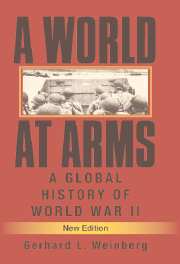Book contents
- Frontmatter
- Dedication
- Contents
- List of Maps
- Preface to the New Edition
- Preface to the First Edition
- List of Abbreviations
- Introduction
- 1 From one War to Another
- 2 From the German and Soviet Invasions of Poland to the German Attack in the West, September I, 1939 to May 10, 1940
- 3 The world Turned Upside Down
- 4 The Expanding Conflict, 1940-1941
- 5 The Eastern Front and a Changing War, June to December, 1941
- 6 Halting the Japanese Advance, Halting the German Advance; Keeping Them Apart and Shifting the Balance: December 1941 to November 1942
- 7 The War At Sea, 1942-1944, and the Blockade
- 8 The War in Europe and North Africa 1942-1943: to and from Stalingrad; to and from Tunis
- 9 The Home Front
- 10 Means of Warfare: Old and New
- 11 From the Spring of 1943 to Summer 1944
- 12 The Assault on Germany from All Sides
- 13 Tensions in Both Alliances
- 14 The Halt on the European Fronts
- 15 The Final Assault on Germany
- 16 The War in the Pacific: From Leyte to the Missouri
- Conclusions: the Cost and Impact of War
- Bibliographic Essay
- Notes
- Maps
- Index
1 - From one War to Another
Published online by Cambridge University Press: 05 February 2014
- Frontmatter
- Dedication
- Contents
- List of Maps
- Preface to the New Edition
- Preface to the First Edition
- List of Abbreviations
- Introduction
- 1 From one War to Another
- 2 From the German and Soviet Invasions of Poland to the German Attack in the West, September I, 1939 to May 10, 1940
- 3 The world Turned Upside Down
- 4 The Expanding Conflict, 1940-1941
- 5 The Eastern Front and a Changing War, June to December, 1941
- 6 Halting the Japanese Advance, Halting the German Advance; Keeping Them Apart and Shifting the Balance: December 1941 to November 1942
- 7 The War At Sea, 1942-1944, and the Blockade
- 8 The War in Europe and North Africa 1942-1943: to and from Stalingrad; to and from Tunis
- 9 The Home Front
- 10 Means of Warfare: Old and New
- 11 From the Spring of 1943 to Summer 1944
- 12 The Assault on Germany from All Sides
- 13 Tensions in Both Alliances
- 14 The Halt on the European Fronts
- 15 The Final Assault on Germany
- 16 The War in the Pacific: From Leyte to the Missouri
- Conclusions: the Cost and Impact of War
- Bibliographic Essay
- Notes
- Maps
- Index
Summary
When a German warship opened fire on the Polish garrison in the special area reserved for them within the Free City of Gdansk (Danzig)—and German troops and airplanes attacked Poland—a terrible conflict began that was quickly called “The Second World War.” This name implies some relationship to the great prior conflict of 1914-18. At the beginning of September 1939, when German actions started this new war, however, there was already fighting in two other areas of the globe. Since the Japanese had struck in northern China in July 1937, there had been hostilities between the two East Asian nations; that war had reached something of a stalemate by the fall of 1939, but no end to it was in sight. In addition, since May 1939, Japanese and Russian troops were engaged in bitter fighting on the border of their respective puppet states in a conflict called after its location the Nomonhan Incident by the Japanese and the Khalkhin-gol Incident by the Russians. Diplomatic relations between the Soviet Union and Japan continued even while their forces clashed, and a cease-fire in this struggle on September 16, 1939, followed upon Japan's defeat in battle. The continuing East Asian conflict between Japan and China would, however, have remained isolated, like the war those two nations had fought in 1894-95, had not events in Europe led Japan to join the hostilities begun there. It is thus entirely appropriate to think of the Second World War as having been initiated by Germany and eventually embroiling the whole globe. How did this come about? Was not one world war enough?
The war which ended with the armistice of November 11, 1918, had been horrendous in its impact on the participants. In more than four years of bloodshed and destruction, vast portions of Europe had been wrecked and the domestic institutions of the continent transformed. The capacity of the modern state for mass mobilization had drawn human and material resources out of each belligerent to an extent no one had previously imagined possible, and these human and material resources had been consumed in the furnace of war.
- Type
- Chapter
- Information
- A World at ArmsA Global History of World War II, pp. 6 - 47Publisher: Cambridge University PressPrint publication year: 2005



